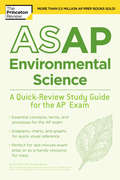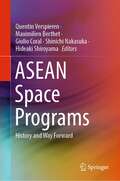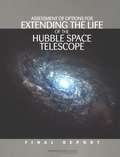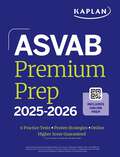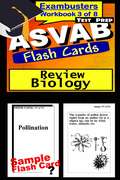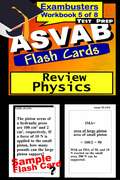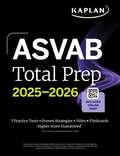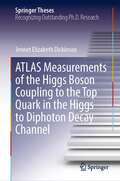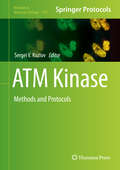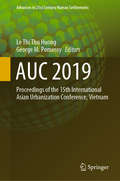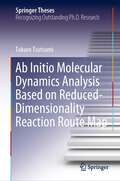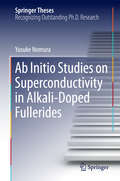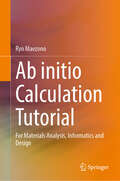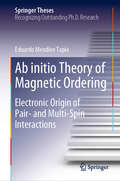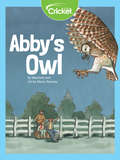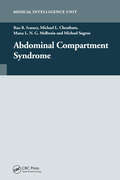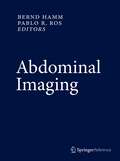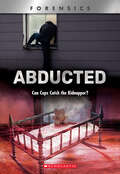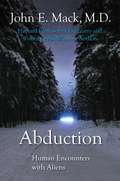- Table View
- List View
ASAP Environmental Science: A Quick-Review Study Guide for the AP Exam (College Test Preparation)
by Princeton ReviewLIKE CLASS NOTES—ONLY BETTER. The Princeton Review's ASAP Environmental Science is designed to help you zero in on just the information you need to know to successfully grapple with the AP test. Advanced Placement exams require students to have a firm grasp of content—you can't bluff or even logic your way to a 5. Like a set of class notes borrowed from the smartest student in your grade, this book gives you exactly that. No tricks or crazy stratagems, no sample essays or practice sets: Just the facts, presented with lots of helpful visuals. Inside ASAP Environmental Science, you'll find:• Essential concepts, terms, principles, issues, and processes for AP Enviro Sci—all explained clearly & concisely• Diagrams, charts, and graphs for quick visual reference• A two-pass icon system designed to help you prioritize learning what you MUST, SHOULD, and COULD know in the time you have available• "Ask Yourself" questions to help identify areas where you might need extra attention• A resource that's perfect for last-minute exam prep and for daily class workTopics covered in ASAP Environmental Scienceinclude:• Ecosystems, food chains & food webs• Population studies & trends• Resource utilization & economics• Energy & conservation... and more!Looking for sample exams, practice questions, and test-taking strategies? Check out our extended, in-depth AP Environmental Science prep guide, Cracking the AP Environmental Science Exam!
ASEAN Space Programs: History and Way Forward
by Hideaki Shiroyama Quentin Verspieren Maximilien Berthet Giulio Coral Shinichi NakasukaThis book presents the first-ever comprehensive analysis of ASEAN space development programs. Written by prominent actors in the region, it goes beyond a mere exposé of the history, current status and future plans of ASEAN space technology development and utilization programs, by analyzing the conditions in which a space program can be initiated in the region. It does so in two ways: on the one hand, it questions the relevance of and motivations behind the inception of space development programs in developing countries, and on the other hand, it focuses on the very specific context of ASEAN (a highly disaster-prone area shaped by unique political alliances with a distinctive geopolitical ecosystem and enormous economic potential, etc.). Last but not least, after having analyzed established and emerging space programs in the region, it provides concrete recommendations for any regional or extra-regional developing nation eager to gain a foothold in space. As such, this book offers a valuable resource for researchers and engineers in the field of space technology, as well as for space agencies and government policymakers.
ASSESSMENT OF OPTIONS FOR EXTENDING THE LIFE OF THE HUBBLE SPACE TELESCOPE: Final Report
by National Research Council of the National AcademiesThe Hubble Space Telescope (HST) has operated continuously since 1990. During that time, four space shuttle-based service missions were launched, three of which added major observational capabilities. A fifth — SM-4 — was intended to replace key telescope systems and install two new instruments. The loss of the space shuttle Columbia, however, resulted in a decision by NASA not to pursue the SM-4 mission leading to a likely end of Hubble’s useful life in 2007-2008. This situation resulted in an unprecedented outcry from scientists and the public. As a result, NASA began to explore and develop a robotic servicing mission; and Congress directed NASA to request a study from the National Research Council (NRC) of the robotic and shuttle servicing options for extending the life of Hubble. This report presents an assessment of those two options. It provides an examination of the contributions made by Hubble and those likely as the result of a servicing mission, and a comparative analysis of the potential risk of the two options for servicing Hubble. The study concludes that the Shuttle option would be the most effective one for prolonging Hubble’s productive life.
ASVAB Premium Prep 2025-2026 (Kaplan Test Prep)
by Kaplan Test PrepASVAB Premium Prep 2025-2026: Your Pathway to Military SuccessWhy Choose ASVAB Premium Prep 2025-2026?Comprehensive Coverage: Our guide offers thorough coverage of all nine ASVAB test sections, including General Science, Arithmetic Reasoning, Word Knowledge, Paragraph Comprehension, Mathematics Knowledge, Electronics Information, Auto and Shop Information, Mechanical Comprehension, and Assembling Objects. You'll have all the content you need to master each section of the test. Expert Strategies: Developed by seasoned ASVAB tutors and military professionals, our test-taking strategies are designed to help you approach each question with confidence. Learn the tips and tricks that can boost your score and ensure you perform at your best on test day. Extensive Practice Materials: Practice is crucial for ASVAB success, and ASVAB Premium Prep 2025-2026 provides: 6 full-length practice tests, available in the book and online, to simulate the actual exam experience. Over 1000+ practice questions with detailed explanations, helping you understand your mistakes and learn from them. Drills and exercises for each test section to reinforce your skills and build your confidence. Customizable Study Plans: Whether you have several months or just a few weeks to prepare, our flexible study plans adapt to your schedule and learning style. Maximize your study time with a plan tailored to your needs and goals. Online Resources: Enhance your preparation with our comprehensive online platform, featuring interactive tutorials, video lessons, and progress tracking tools. Stay motivated and on track with resources designed to support your learning every step of the way. Updated for 2025-2026: Stay ahead with the most current information. Our guide is meticulously updated to reflect the latest changes and trends in the ASVAB exam, ensuring you're studying the most accurate and relevant material. Why It Stands Out:ASVAB Premium Prep 2025-2026 is more than just a study guide; it's a comprehensive preparation system designed to help you succeed. With extensive content coverage, expert strategies, abundant practice materials, and advanced online resources, it offers unparalleled value for aspiring military personnel. Choose ASVAB Premium Prep 2025-2026 and take the first step towards a successful military career. With our guide, you'll be well-prepared to achieve your best possible ASVAB scores and secure your place in the armed forces.
ASVAB Test Prep Flash Cards: Biology (Exambusters ASVAB Workbook #3 of 8)
by Ace Inc.<P><P><i>Advisory: Bookshare has learned that this book offers only partial accessibility. We have kept it in the collection because it is useful for some of our members. Benetech is actively working on projects to improve accessibility issues such as these.</i><P><P> 450 questions and answers.<P><P> Topics: Cells, Biochemistry and Energy, Evolution, Kingdoms: Monera, Fungi, Protista, Plants, Animals; Human: Locomotion, Circulation, Immunology, Respiration, Excretion, Digestion, Nervous System <P>EXAMBUSTERS ASVAB Prep Workbooks provide comprehensive, fundamental ASVAB review--one fact at a time--to prepare students to take practice ASVAB tests. Each ASVAB study guide focuses on one specific subject area covered on the ASVAB exam. From 300 to 600 questions and answers, each volume in the ASVAB series is a quick and easy, focused read. Reviewing ASVAB flash cards is the first step toward more confident ASVAB preparation and ultimately, higher ASVAB exam scores!
ASVAB Test Prep Flash Cards: Chemistry (Exambusters ASVAB Workbook #4 of 8)
by Ace Inc.<P><P><i>Advisory: Bookshare has learned that this book offers only partial accessibility. We have kept it in the collection because it is useful for some of our members. Benetech is actively working on projects to improve accessibility issues such as these.</i><P><P> 700 questions and answers. Essential chemistry formulas and concepts you need.<P><P> Topics: Metric System, Matter, Atoms, Formulas, Moles, Reactions, Elements, Chemical Bonds, Phase Changes, Solutions, Reaction Rates, Acids and Bases, Oxidation and Reduction, Introduction to Organic Chemistry<P> <P>EXAMBUSTERS ASVAB Prep Workbooks provide comprehensive, fundamental ASVAB review--one fact at a time--to prepare students to take practice ASVAB tests. Each ASVAB study guide focuses on one specific subject area covered on the ASVAB exam. From 300 to 600 questions and answers, each volume in the ASVAB series is a quick and easy, focused read. Reviewing ASVAB flash cards is the first step toward more confident ASVAB preparation and ultimately, higher ASVAB exam scores!
ASVAB Test Prep Flash Cards: Physics (Exambusters ASVAB Workbook #5 of 8)
by Ace Inc.<P><P><i>Advisory: Bookshare has learned that this book offers only partial accessibility. We have kept it in the collection because it is useful for some of our members. Benetech is actively working on projects to improve accessibility issues such as these.</i><P><P> 600 questions and answers. Sample problems. <P><P>Topics: Metric System, Motion and Forces, Work and Energy, Fluids, Sound, Light and Optics, Static Electricity, D.C. and A.C. Circuits, Magnetism <P>EXAMBUSTERS ASVAB Prep Workbooks provide comprehensive, fundamental ASVAB review--one fact at a time--to prepare students to take practice ASVAB tests. Each ASVAB study guide focuses on one specific subject area covered on the ASVAB exam. From 300 to 600 questions and answers, each volume in the ASVAB series is a quick and easy, focused read. Reviewing ASVAB flash cards is the first step toward more confident ASVAB preparation and ultimately, higher ASVAB exam scores!
ASVAB Total Prep 2025-2026 (Kaplan Test Prep)
by Kaplan Test PrepASVAB Total Prep 2025-2026: Your Complete Guide to ASVAB ExcellenceWhy Choose ASVAB Total Prep 2025-2026?Unmatched Comprehensive Content: Our guide provides in-depth coverage of all nine ASVAB test sections: General Science, Arithmetic Reasoning, Word Knowledge, Paragraph Comprehension, Mathematics Knowledge, Electronics Information, Auto and Shop Information, Mechanical Comprehension, and Assembling Objects. You'll have everything you need to master each section and excel on the test. Advanced Test-Taking Strategies: Learn from experts with our proven test-taking strategies. Developed by experienced ASVAB tutors and military professionals, these techniques help you tackle each question with confidence and efficiency, maximizing your score potential. Extensive Practice Resources: Practice is key to success, and ASVAB Total Prep 2025-2026 delivers with: 7 full-length practice tests, available both in the book and online, to closely simulate the actual exam experience. Over 2,000+ practice questions with detailed explanations to help you understand your mistakes and improve. Targeted drills and exercises for each test section, designed to reinforce your knowledge and boost your skills. Plus flashcards in the book and also in an app to review on the go. Customizable Study Plans: Whether you have several months or just a few weeks to prepare, our flexible study plans are tailored to fit your schedule and learning style. Optimize your study time with a plan that adapts to your unique needs and goals. Interactive Online Resources: Enhance your preparation with our state-of-the-art online platform, featuring interactive tutorials, video lessons, customizable quizzes, and progress tracking tools. Stay motivated and on track with resources designed to support your learning journey. Updated for 2025-2026: Stay current with the latest information. ASVAB Total Prep 2025-2026 is meticulously updated to reflect the most recent changes and trends in the ASVAB exam, ensuring you're studying the most accurate and relevant material. Why It Stands Out:ASVAB Total Prep 2025-2026 is more than just a study guide—it's a complete preparation system designed to help you succeed. With unparalleled comprehensive content, expert strategies, abundant practice materials, and cutting-edge online resources, it offers the best value for ambitious military candidates.
ATEX--Explosive Atmospheres: Risk Assessment, Control and Compliance (Springer Series in Reliability Engineering)
by Torben JespenThis book details how safety (i. e. the absence of unacceptablerisks) is ensured in areas where potentially explosive atmospheres (ATEX) canarise. The book also offers readers essential information on how to comply withthe newest (April 2016) EU legislation when the presence of ATEX cannot beavoided. By presenting general guidance on issues arising out of the EUATEX legislation - especially on zone classification, explosion risk assessment,equipment categorization, Ex-marking and related technical/chemical aspects -the book provides equipment manufacturers, responsible employers, and otherswith the essential knowledge they need to be able to understand the different -and often complicated - aspects of ATEX and to implement the necessary safetyprecautions. As such, it represents a valuable resource for all those concernedwith maintaining high levels of safety in ATEX environments.
ATLAS Measurements of the Higgs Boson Coupling to the Top Quark in the Higgs to Diphoton Decay Channel (Springer Theses)
by Jennet Elizabeth DickinsonDuring Run 2 of the Large Hadron Collider, the ATLAS experiment recorded proton-proton collision events at 13 TeV, the highest energy ever achieved in a collider. Analysis of this dataset has provided new opportunities for precision measurements of the Higgs boson, including its interaction with the top quark. The Higgs-top coupling can be directly probed through the production of a Higgs boson in association with a top-antitop quark pair (ttH). The Higgs to diphoton decay channel is among the most sensitive for ttH measurements due to the excellent diphoton mass resolution of the ATLAS detector and the clean signature of this decay. Event selection criteria were developed using novel Machine Learning techniques to target ttH events, yielding a precise measurement of the ttH cross section in the diphoton channel and a 6.3 $\sigma$ observation of the ttH process in combination with other decay channels, as well as stringent limits on CP violation in the Higgs-top coupling.
ATM Kinase: Methods and Protocols (Methods in Molecular Biology #1599)
by Sergei V. KozlovAtaxia-telangiectasia (A-T) is a rare and severe genetic disorder affecting children. A-T is a multisystem disease characterized by progressive neurodegeneration, immunodeficiency and cancer predisposition. This detailed volume explores the ever expanding field of research into the ATM (ataxia-telangiectasia, mutated) gene and the role played by ATM kinase in DNA damage signaling and diverse cellular processes. What follows is a handy desktop reference for both seasoned A-T researchers and postgraduate students, as it demonstrates the breadth of recent developments in A-T studies. Written for the highly successful Methods in Molecular Biology series, chapters include introductions to their respective topics, lists of the necessary materials and reagents, step-by-step, readily reproducible laboratory protocols, and tips on troubleshooting and avoiding known pitfalls. Both classic and cutting-edge techniques are described, including ATM gene mutation detection, assays for radiosensitivity and radioresistant DNA synthesis, new methods to measure ATM kinase activity by imaging microscopy and high content screening as well as proteomics, phosphoproteomics and bioinformatics approaches to decipher ATM-dependent signalling pathways. Additional methods include generation of patient-specific stem cells and approaches to study ATM functions in the nervous system. Comprehensive and practical, ATM Kinase: Methods and Protocols aims to ignite and attract the interest of colleagues from diverse fields to A-T research in an effort to bring their expertise and fresh ideas to resolve many A-T puzzles still waiting to be pieced together and to alleviate the suffering of A-T children and their families.
AUC 2019: Proceedings of the 15th International Asian Urbanization Conference, Vietnam (Advances in 21st Century Human Settlements)
by George M. Pomeroy Le Thi Thu HuongThis book presents selected articles from the 15th International Asian Urbanization Conference, held in Ho Chi Minh City, Vietnam, on November 27-30, 2019. Bringing together researchers and professionals in the area of urban planning and development to better understand the growing need for sustainable urban life, it covers topics such as climate change and urban resilience; inclusive and implementable urban governance; smart and green mobility; transformations in land management; livable and smart cities; integrated planning and development; urban slums and affordable housing; sustainable urban finance; and urban renewal and redevelopment.
Aani & the Tree Huggers
by Jeannine AtkinsBased on true events in India in the 1970s, young Aani and the other women in her village defend their forest from developers by wrapping their arms around the trees, making it impossible to cut them down.
Aaron Klug A Long Way from Durban
by Holmes Kenneth C.The atomic structures of macromolecules provide the key to understanding how life works. Aaron Klug led the way in the development of methods for solving such structures and is one of the pioneers of structural molecular biology. He was awarded a Nobel Prize in 1982 for his work. Illuminating both his personal life and scientific achievements, this unique biography begins with Klug's youth in Durban and his studies at Johannesburg, Cape Town and then Trinity College, Cambridge. Holmes proceeds to explore Klug's career from his work on the structure of viruses with Rosalind Franklin at Birkbeck College, London to his time as Director of the MRC Laboratory of Molecular Biology (LMB) in Cambridge and as President of the Royal Society. Drawing on their long-term collaboration, interviews and unique access to Klug's archives, Holmes provides a fascinating account of an innovative man and his place in the history of structural molecular biology.
Ab 40 bewirbt man sich anders. Durchstarten mit Lebenserfahrung - Bewerbungsstrategien, Informationen, Mutmacher - mit Musterdokumenten: Durchstarten Mit Lebenserfahrung  Bewerbungsstrategien, Informationen, Mutmacher  Mit Musterdokumenten
by Anita EggertAnlässe für Menschen ab 40, sich neu zu bewerben, gibt es viele: Eine Stellenanzeige reizt zu einem beruflichen Neustart, nach einer Erziehungspause steht der Wiedereinstieg an o. ä. Das Buch unterstützt Bewerber, indem es einen systematischen Überblick über alle Phasen gibt: von der Stellensuche über das Telefoninterview bis zum Bewerbungsgespräch. Die Autorin liefert die wichtigsten Tipps für eine zeitgemäße und korrekte Bewerbung sowie Hilfen, um zu einer selbstbewussten inneren Haltung zu finden. Begleitende Website mit Arbeitsmaterialien.
Ab Initio Molecular Dynamics Analysis Based on Reduced-Dimensionality Reaction Route Map (Springer Theses)
by Takuro TsutsumiThis thesis proposes useful tools, on-the-fly trajectory mapping method and Reaction Space Projector (ReSPer), to analyze chemical reaction mechanisms by combining the reaction route map and the ab initio molecular dynamics. The key concept for the proposed tools is the Cartesian distance between pairwise molecular structures, and a practical procedure to get the optimal distance is introduced. The on-the-fly trajectory mapping method tracks the distance function between reference structures and molecular structures along the trajectory. Although this method provides fruitful insight into dynamic reaction behaviors, the visualization of reaction routes into a low-dimensional space is still challenging because of the multi-dimensionality. ReSPer successfully constructs a low-dimensional reaction space defined by mathematically-selected principal coordinates representing mutual distance relationships in the full-dimensional space. ReSPer also enables us to project trajectories into the reaction space in the reduced dimension. In this thesis, these methods are applied to several reactions, including bifurcating and photochemical reactions, revealing dynamically-allowed reaction mechanisms. This thesis provides robust and versatile tools to elucidate dynamical reaction routes on the basis of the reduced-dimensionality reaction route map and will help control chemical reaction dynamics and select descriptors for machine learning.
Ab Initio Molecular Dynamics: Basic Theory and Advanced Methods
by Dominik Marx Jürg HutterAb initio molecular dynamics revolutionized the field of realistic computer simulation of complex molecular systems and processes, including chemical reactions, by unifying molecular dynamics and electronic structure theory. This book provides the first coherent presentation of this rapidly growing field, covering a vast range of methods and their applications, from basic theory to advanced methods. This fascinating text for graduate students and researchers contains systematic derivations of various ab initio molecular dynamics techniques to enable readers to understand and assess the merits and drawbacks of commonly used methods. It also discusses the special features of the widely used Car-Parrinello approach, correcting various misconceptions currently found in research literature. The book contains pseudo-code and program layout for typical plane wave electronic structure codes, allowing newcomers to the field to understand commonly used program packages and enabling developers to improve and add new features in their code.
Ab Initio Studies on Superconductivity in Alkali-Doped Fullerides (Springer Theses)
by Yusuke NomuraThis book covers high-transition temperature (Tc) s-wave superconductivity and the neighboring Mott insulating phase in alkali-doped fullerides. The author presents (1) a unified theoretical description of the phase diagram and (2) a nonempirical calculation of Tc. For these purposes, the author employs an extension of the DFT+DMFT (density-functional theory + dynamical mean-field theory). He constructs a realistic electron-phonon-coupled Hamiltonian with a newly formulated downfolding method. The Hamiltonian is analyzed by means of the extended DMFT. A notable aspect of the approach is that it requires only the crystal structure as a priori knowledge. Remarkably, the nonempirical calculation achieves for the first time a quantitative reproduction of the experimental phase diagram including the superconductivity and the Mott phase. The calculated Tc agrees well with the experimental data, with the difference within 10 K. The book provides details of the computational scheme, which can also be applied to other superconductors and other phonon-related topics. The author clearly describes a superconducting mechanism where the Coulomb and electron-phonon interactions show an unusual cooperation in the superconductivity thanks to the Jahn-Teller nature of the phonons.
Ab initio Calculation Tutorial: For Materials Analysis, Informatics and Design
by Ryo MaezonoThis textbook covers the framework of first-principles analysis applied to materials using density functional theory (DFT). It provides a set of hands-on tutorials using the Quantum ESPRESSO package, an open-source software for DFT. The tutorials are well chosen, designed for maximum effectiveness while requiring a minimum of the reader’s time, and the book describes how the essential components are combined to create the practical applications based on the idea of modeling practical problems of materials. The book carefully explains how to prepare the platform to run the tutorials assisted by free software. This textbook is useful for students in experimental laboratories, for industrial researchers, and for those not majoring in theoretical studies but learning individually.
Ab initio Theory of Magnetic Ordering: Electronic Origin of Pair- and Multi-Spin Interactions (Springer Theses)
by Eduardo Mendive TapiaMany technological applications exploit a variety of magnetic structures, or magnetic phases, to produce and optimise solid-state functionality. However, most research advances are restricted to a reduced number of phases owing to computational and resource constraints. This thesis presents an ab-initio theory to efficiently describe complex magnetic phases and their temperature-dependent properties. The central assumption is that magnetic phases evolve slowly compared with the underlying electronic structure from which they emerge. By describing how the electronic structure adapts to the type and extent of magnetic order, a theory able to describe multi-spin correlations and their effect on the magnetism at finite temperature is obtained. It is shown that multi-spin correlations are behind the temperature and magnetic field dependence of the diverse magnetism in the heavy rare earth elements. Magnetically frustrated Mn-based materials and the effect of strain are also investigated. These studies demonstrate that the performance of solid-state refrigeration can be enhanced by multi-spin effects.
Abby's Owl
by Maureen AshAbby wanted to be a penguin in the school play, but she's cast as an owl instead! After getting a lesson on the importance of barn owls on farms, Abby realizes how amazing owls can be.
Abdominal Compartment Syndrome
by Rao IvaturyFirst suggested in 1863 by Marey, abdominal compartment syndrome, (ACS), is a constellation of the physiologic sequelae of increased intra-abdominal pressure, (IAP), termed intra-abdominal hypertension, (IAH). Recent observations suggest an increasing frequency of this complication in all types of patients, neonates to the elderly and in diverse cl
Abdominal Imaging (Learning Imaging Ser.)
by Pablo R. Ros Bernd HammIn this book a team of leading experts come together to provide a comprehensive overview of modern imaging of the abdomen and pelvis, with detailed sections on both gastrointestinal and genitourinary imaging. Each chapter has an identical structure and focuses on a particular organ or organ system, allowing the reader to approach the field one topic at a time. Indications for a variety of imaging techniques and examination protocols are clearly described, and the imaging features of normal anatomy and pathologic entities are depicted in an abundance of high-quality images. Care is taken to consider all recent technical developments and new indications, and the diagnostic performance of different imaging modalities is carefully compared. It is anticipated that this book will come to be regarded as the standard work of reference on abdominal and pelvic radiology.
Abducted: Can Cops Catch the Kidnapper? (XBooks: Forensics)
by Diane WebberCan the kidnapper be caught?Charles Lindbergh was a very famous public figure whose son was kidnapped from his crib. Much of the investigation was based on a series of ransom notes which ultimately led to the conviction of a suspect.High-interest topics, real stories, engaging design, and astonishing photos are the building blocks of the XBooks, a new series of books designed to engage and motivate reluctant and enthusiastic readers alike. How can DNA help a convicted person prove their innocence? How did a burglar steal from a store without leaving any fingerprints? Why was the tiny town in Hardin, Missouri, awash with skeletons after a huge flood? With topics based in science, these action-packed books will help students unlock the power and pleasure of reading... and always ask for more!
Abduction: Human Encounters with Aliens
by John E. MackJohn E. Mack, M.D., has investigated nearly one hundred cases of alien abduction and has conducted hundreds of hours of interviews and treatment. He takes his clients' accounts seriously, and in Abduction he makes clear why he believes their testimony may transform the foundations of human thought as profoundly as did Copernicus's proof that the earth is not the center of the universe. Writing with the authority and insight that have been the hallmarks of his distinguished career as a psychiatrist and writer, Dr. Mack emphasizes his clients' psychological and spiritual transformations, and he illuminates the vast implications of the abduction experience for his understanding of human psychology and of our identity as a species on this planet.<P> Never before has a book on alien abductions included case histories from such a wide cross-section of men and women from a variety of geographic regions and economic and educational levels, who had never met one another or compared their stories. Abduction will persuade every reader with an open mind that these accounts are not hallucinations, not dreams, but real experiences. Throughout Abduction, Dr. Mack focuses especially on the supportive and collaborative relationship between doctor and client. Here are vivid, dramatic, often inspiring stories of people undergoing - and triumphantly coming to understand - the greatest traumas of their lives. In Dr. Mack's retellings, these accounts of alien abduction become human interest stories of stirring emotional power. Eye-opening, provocative, and above all authoritative, Abduction makes an important contribution to the literature on human consciousness.
